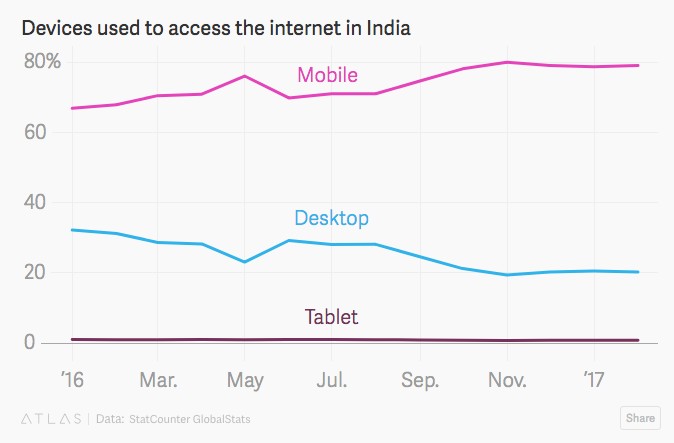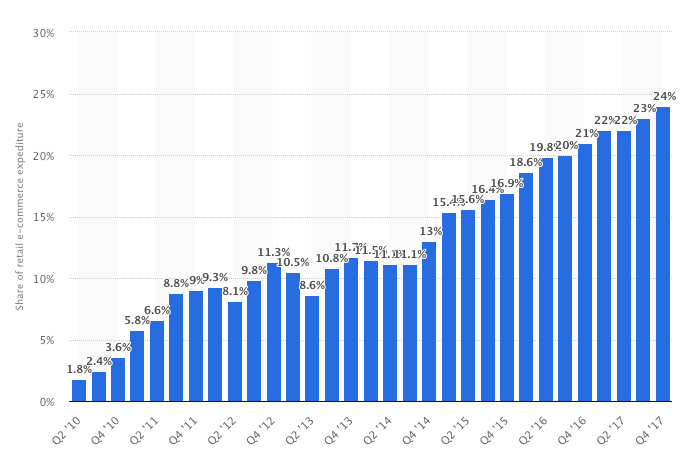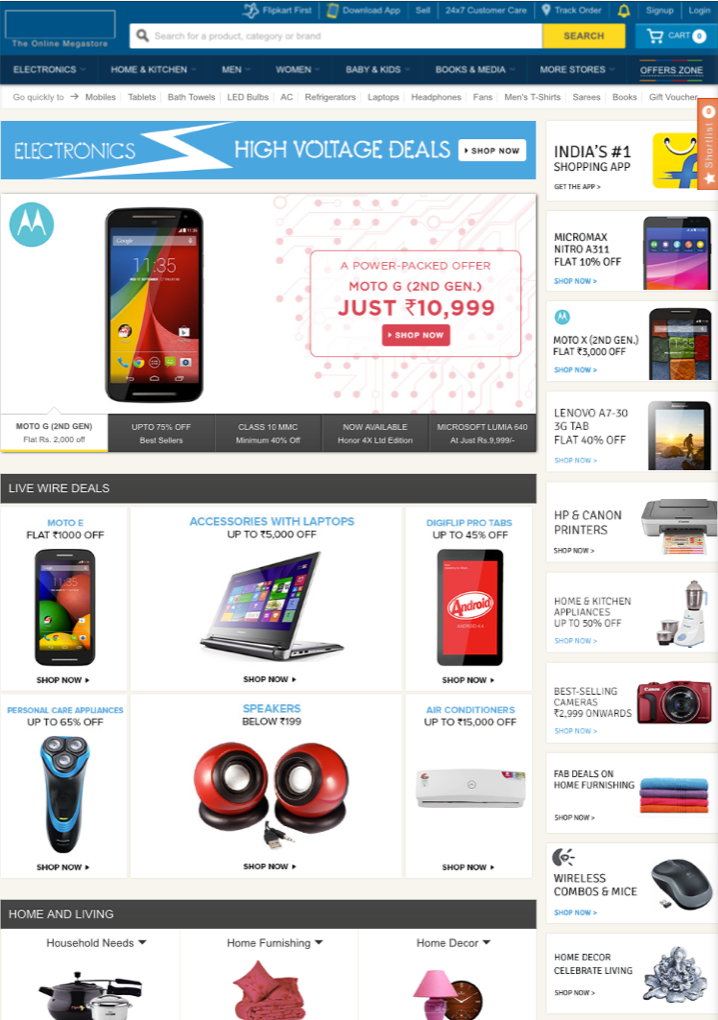By: Nicole Silberstein, Hamutal Schieber
Walmart’s recent acquisition of Indian e-commerce platform Flipkart will give the world’s largest retailer a stronghold in one of the hottest growth markets of the moment, but the deal also has the potential to give Walmart another edge, one with global implications. That is, in the world of mobile commerce, thought by many to be the future of retail, and a playing field where Flipkart has unique expertise.
Walmart announced on May 9 that it would become the largest shareholder in Flipkart Group, paying $16 billion for a 77 percent stake in the company, and winning out against Amazon in a deal that marks Walmart’s largest acquisition ever (nearly five times the $3.3 billion it paid for Jet.com in 2016).
“India is one of the most attractive retail markets in the world, given its size and growth rate, and our investment is an opportunity to partner with the company that is leading transformation of e-commerce in the market,” said Doug McMillon, Walmart’s president and CEO, in the company’s official announcement of the deal. “As a company, we are transforming globally to meet and exceed the needs of customers, and we look forward to working with Flipkart to grow in this critical market.”
The Indian market is indeed a critical one for global retailers, representing perhaps the single biggest growth opportunity in the world today, with a population of 1.3 billion people whose spending power and digital access is increasing by the day. A recent report from Morgan Stanley estimates that India’s e-commerce market will reach $200 billion by 2026.
That alone is enough to justify the deal, but there’s another huge advantage to entering the Indian e-commerce market–the country is uniquely primed for mobile commerce.
India already has as many smartphone users as the U.S. has people – a little over 300 million with 176 million more to be added in the next five years according to a 2017 study from Counterpoint Research.
In fact, Indian consumers rely more heavily on phones to access the web than any other country in the world, with users accessing the Internet through their mobile nearly 80 percent of the time. (Source: StatCounter GlobalStats). In many ways, India has skipped over desktops completely and entered the Internet age directly through smartphones.

Devices used to access the internet in India; source: https://www.theatlas.com/charts/HJcNgwFhe
The reasons for this are economic as much as they are about preference – not only does a computer cost more than a smartphone, but power issues are widespread throughout the country.
All of these factors combine to give India one of the most mobile-driven consumer bases in the world. At the same time, consumers across the globe are increasingly making their purchases on mobile devices.
Over the last seven years, the percentage of e-commerce dollars spent via mobile devices in the U.S. has increased exponentially, from 1.8% in Q2 2010 to 24% in Q4 2017. And the U.S. is by no means the leading market for mCommerce, with other countries like the U.K., Japan, Australia and South Korea, using mobile devices even more frequently than their U.S. counterparts to make online purchases. (Source: Statista)

M-commerce share of total digital commerce spending in the United States from 2nd quarter 2010 to 4th quarter 2017. Source: Statista
During this same time period, Flipkart (which launched in 2007) was busy building a sophisticated e-commerce platform that could accommodate the unique dynamics of the Indian market, where spotty internet connectivity is still a frequent occurrence.
In fact, the unique combination of a large, mobile-driven consumer base, but unreliable infrastructure, has been formative in the direction Flipkart has taken and where it is today.
In 2015, the company announced that it was turning off its website and directing all shoppers to its app. The company had not, up to that point, been able to replicate the streamlined, engaging shopping experience of its app on its website, a problem that was exacerbated by the country’s unreliable internet. The engagement and conversion metrics of app users were much stronger than those of customers who visited Flipkart online, according to Peeyush Ranjan, Flipkart CTO, and so the company made the decision to push all consumers to its app.
Customers however, were less than pleased with the app-only strategy, and within a few months the Flipkart website was back, but in a vastly different form, indicating the need for an omni-channel, and not a mobile-only strategy.
In response to the customer outcry at the removal of its website, Flipkart focused with renewed energy on the website experience. The result was Flipkart Lite, a mobile website that feels and works like a downloadable app but operates on the open web, with low data usage and fast speeds to boot. Placed alongside its already strong app platform, the e-tailer (and its customers) suddenly had the best of both worlds. Through a little bit of trial and error, the company had become, in a matter of months, not only a mobile-friendly platform, but a mobile-first one.

Before: Flipkart website (mobile site). Source: WayBack Machine

After: Flipkart Lite (mobile)
The results were undeniable, with Flipkart reporting huge bumps in time spent on site, re-engagement (bringing the shopper back after they’ve left your site) and conversion rates following the launch of Flipkart Lite. [3x more time spent on site, 40% increase in re-engagement rate, 70% increase in conversion among those arriving via Add to Homescreen; Source: Google Developers]
In light of all this, Walmart’s decision to spend $16 billion for a controlling stake in this regional e-commerce platform begins to look, at least in part, like a global play for mobile dominance.
Walmart is by no means a novice in the world of mobile commerce, but the kind of insights it will be able to glean from Flipkart’s past and future mobile endeavours could be invaluable to remaining ahead of the curve, and Walmart CEO Doug McMillon said as much on a call with analysts May 9 after the acquisition was announced.
“At Walmart, we’re learning how to build–and how to partner to build–retail ecosystems around the world. India will now become a key center of learning for our entire company,” he said.
COO Judith McKenna offered further insight into exactly what the company thinks it can learn from Flipkart.
“Not only is [Flipkart] innovative [with the] problem-solving culture that they have, but they are doing some great work both in the AI space, how they are using data across their platforms, but particularly in terms of the payment platform that they’ve created through PhonePe,” she said on the call. “All of those things we can learn from for the future and see how we can leverage those around the international markets and potentially into the U.S. as well.”
Here are some of the Flipkart initiatives that could be of particular interest to Walmart’s mobile ambitions, and more:
- Artificial Intelligence & Machine Learning: Last December, Flipkart Executive Chairman and co-founder Sachin Bansal, unveiled an initiative called AI for India, designed to spur the development of AI solutions for e-commerce, and beyond, in the country. Flipkart already uses AI for personalization, product discovery, search, fraud protection, logistics, cataloging and more, and its continued investment in the space is expected to further increase the application of these technologies across the company’s e-commerce ecosystem.
- Mobile Payments: The company’s mobile payment platform PhonePe, akin to PayPal or Venmo, is helping to transform the way Indian consumers pay for products and services, both online and offline (for point-of-sale transactions using Bluetooth technology).
- Use of Consumer Data: The sheer size of Flipkart’s consumer base (13 million visitors a day) means that the company has quickly become adept at processing huge amounts of data daily, 1.2 petabytes every day, in fact (Source: Flipkart). Given its history of agile innovation, Flipkart’s ongoing efforts to find new, better ways to manage and utilize consumer data could offer invaluable insights that Walmart can apply globally.
- Top-Tier Tech Partners: The remaining 23 percent stake in Flipkart will continue to be held by existing Flipkart shareholders that include Tencent and Microsoft, thereby aligning Walmart with two major tech players.
The Flipkart acquisition isn’t the only big move that Walmart has made this year. In April, the company announced that it would be selling off its majority stake in the steadfast, but slower growing, U.K. retailer Asda.
It’s clear that Walmart is hyper-focused at remaining at the forefront of digital retail, and the Flipkart acquisition may well prove a key piece of achieving that ambition.

